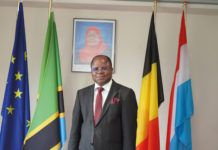Uganda is a country with a troubled past, but has managed to transform itself into a land of stability and prosperity. Under the leadership of President Yowerin Musevini, the governement is pushing to make the objectives of the Uganda 2040 vision happen. The aim is to obtain an upper mid level country within the set timeframe. In order to pursue this, National Development Plans are followed, including major reforms such as stabilization and pro-market structural reforms, important infrastructures works and rural development. Today its economy stand strong with projected GDP rates of 7%, and a promising future thanks to the discovery of oil reserves, bringing many investments opportunities. The road ahead is promising.
The population of Uganda is 35 millions over a territory of over 240.000 sq kilometres. Since its independance from the British in 1962, the Ugandan story has not been the most quiet one until the arrival of President Musevini in 1986, bringing with him a return to stability and economic growth. Real gross domestic growth averaged 7% a year from 1987 to 2010. After 2010, there was a drop in the growth but today, the Ugandan Economy is standing strong with a growth rate of 5,9% in 2016, predicted at 6,8% in 2017-2018.
The Comprehensive National Development Planning Framework was presented in 2007. It provides for the development of a 30 year vision, implemented through three 10-year plans, six five-year National Development Plans, Sector Investment Plans, Local Governement Development Plans, Annual work plans and budgets.
All of these plans and strategies are working for one aim: the National Vision Statement “A transformed Ugandan society from a peasant to a modern and prosperous country within 30 years”. The Uganda vision 2040 gives clear strategies and directions to transform the country into a competitive upper middle incrom country with a per capita income of USD 9,500.
In order to achieve the vision, a GDP growth rate of 8,2% must be achieved on a yearly basis. The vision integrates lessons learnt from past strategies such as Vision 2025 and Draft Vision 2035. It also takes into account the discovery of oil and gas reserves which will be exploited soon, green econmy, demographic profile, digitalisation and regional economic challenges, amongst others.
The Second National Development Plan was launched in 2016, focusing on improving health, education, mineral exploitation, transport and agriculture.
Power for development
Upgrading the transportation network and electrity generating capacity is Uganda’s top economic priority. Needed for business and agricultural purposes, the electricity and roads are vital to continue the country’s development. Development of electricity distribution in rural areas will allow farmers to connect to trading centers and thus improve the value of their production, enhancing population welfare.
Regarding the energetical self-sufficiency aim, two major power development projects are being developed. The first one is the Isimba Power Station, coming online in 2016 and able to deliver 183MW and the second being the Karuma Power Station, which will be ready in 2018 and will provide 600MW. While the Bujagali Fall dam was completed in 2012 and brought some relief to the economic sector through a capacity of 250MW, for many business energy shortages are the main issue to deal with. Uganda has brought hydro-power as a response to relieve the sector and the two new dams should bring a good response to allow growth to continue. The governement has made it a priority to be bring a permanent response to Uganda’s energy shortages and thus ensure economic growth persistance.
Uganda’s geographical location, combined with future electricity surplus gives it great possibilities within the East African Region. The production overflow will be exported to neighboring countries such as Easter Congo, Rwanda amongst others. Better road infrastructures will enhance the mobility and transportation of goods to seaports.
Oil was found in Uganda in 2006, a great opportunity for the country and its investors. Exploitation is expected to begin around 2021 but requires the installation of new infrastructures. These investments will done in a private-public partership, including the construction of road, a crude oil pipeline, a small-scale refinery and product pipelines.
In total, Uganda has discovered 6,5 billion barrels along the Lake Albert. Currently, the oil fields are owned by three companies ; Total E&P, Tullow Oil and CNOOC.
Two major project which are vital to the good exploitation of the new-found oil in Uganda are the Uganda-Tanzania oil pipeline and the Kabala refinery.
The future pipeline of 1403 kilometre will transport crude oil from Hoima in Uganda to Tanga Port in Tanzanie, passing through Kagera, GEita, Shinyanga, Tabora and Singida. The project should be completed by June 2020, according to the Minister for Energy and Minerals, Pr. Sospeter Muhongo.
The line should transport 200.000 barrels of crude oil per day for export. It is expected that the project will create 15.000 jobs and the permanent jobs, after construction, should include 1000 to 2000 jobs.
At present, three companies own 33.3 per cent each of the oil fields and they include Total E&P, Tullow Oil and CNOOC. An oil refinery will be build by the companies, with a capacity to process 60,000 barrels per day for petroleum products in East Africa.
One of the objectives of the Comprehensive National Development Planning Framework is to obtain an independent and self-sustaining economy. Instead of exporting unprocessed raw goods and materials, the country wants to create industry parks to process them such as to be able to cover its internal needs. As such, the Uganda Investment Authority has received the mission to build 22 industrial parks in various regions of the country making way for the production of honey, fruits, textiles, fish processing and many others.
Currently, three major industrial parks are being developed, the Mbale Industrial & Business Park in de Mbale distict, the Gulu Industrial Park in the Gulu District or fruit, oil, seeds, sugar and url rice and the Mbarara Park.
According to the Uganda Investment Authority, investors should be interested in the following sectors;
Agriculture – agribusiness
Uganda is among the leading producers of coffee, bananas and oil seed crops (sesame (simsim), soybean, sunflower, etc). It is also a major producer of other crops like tea, cotton organic cotton, tobacco, cereals, fresh fruit & vegetables and nuts, essential oils, flowers, poultry, fresh water fish.
Opportunities for investment exist in:
- Commercial farming in both crops and animal industries, as well as aquaculture;
- Value addition (Agro-industries -Agro-food industries;
- Manufacturing of inputs (fertilizers, pesticides etc);
- Cold storage facilities and logistics;
- Farm Machinery manufacturing and assembly;
- Packaging;
- Irrigation Schemes.
The country has been zoned into specific production areas and in order to ease logistics and supply of Agricultural products / source of raw materials, all these areas are well linked to a good national road grid network.
Tourism
The distinctive attraction of Uganda as a tourist destination arises from the variety of its game stock (Including the rare tree climbing lions of Ishasha White Rhinoceros, Gorillas, elephants and its unspoiled scenic beauty including forests hills and Mountain Rivers and lakes. 51% of the world’s population of mountain gorillas lives in Uganda.
Uganda is home to 11% of the world’s bird’s species (a total of 1060 birdspecies) which offers a wide range of bird species.
The opportunities in tourism range from constructing high quality accommodation facilities, operating tours and travel circuits (bicycle tours, air balloon travel, marine – Lake Victoria and river rafting on the River Nile) to the development of specialized eco and community tourism systems, as well as faith based tourism (pilgrimage to Namugongo – Uganda Martyrs, Mahatma Gandhi Statute and Bishop Hannington landing site on the Nile River).
Mining
Over 80% of the country has been surveyed for mineral quantities and locations. New geo-data shows that Uganda has large under-exploited mineral deposits of gold, oil, high grade tin, tungsten/wolfram, salt, beryllium, cobalt, kaolin, iron-ore, glass sand, vermiculite, phosphates (agricultural fertilizer), Uranium and rare earth elements.
There are also significant quantities of clay and gypsum. Gold occurs in many areas of the country, including Busia in the east, Buhweju and Kigezi in the west, Mubende – Kiboga in the central region and significant occurrences in Karamoja in the north east.
Investment opportunities exist in mining and mineral processing. Uganda provides special incentives to the mining sector with some capital expenditures being written off in full.
The Uganda Mining Act of 2003 and Mining Regulation 2004 grant five types of mining rights. These include:
Prospecting license;
- Exploration license;
- Retention license;
- Mining lease;
- Location license.
Oil & Gas
The discovery of extractable quantities of oil and gas in the Lake Albert region has enhanced the sector’s joie de vivre. According to the Petroleum Exploration and Production Department, 21 oil and/or gas discoveries have been made in the country to date. Petroleum laws are in place and a communication desk to disseminate information related to the oil and gas sector was created within the Ministry of Energy and Mineral Development.
Investment opportunities available in middle and down streams in the Sector.
More information on the sector can be got from the Website: www.petroleum.go.ug
Renewable energy
Uganda has considerable unexploited renewable energy resources for energy production and provision of energy services. The overall Government
The goal of Uganda Renewable Energy Policy is to increase the use of modern renewable from below 5% in 2007 to 61% of the total energy consumption by 2017
ICT
Uganda’s Information and Communication Technology (ICT) sector is one of the most vibrant within the region and fastest growing sector in the economy. This vibrancy hinges largely on the good legal and regulatory frameworks. The supportive investment climate therein has exposed numerous opportunities in ICT innovation services leading to maximum utilization of the existing youthful human resource base as quite suitable for the ICT work.
The newly developed and highly qualitative ICT infrastructure is also ready to accommodate more future investments. Uganda is now connected to three marine fibre optic cables running around African eastern coast in the Indian Ocean .
Uganda is positioning itself to be the hub for Business Processing and Management Outsourcing industry with the region on the Africa’s Eastern cost.
Numerous Investment Opportunities exist in the local, Regional and International markets .The largest of the Uganda Business Process Outsourcing, Information Technology and Information Technology Enabling Services. Industry opportunities are within Agriculture, Health, Tourism, Banks insurance and public administration.
Domestic opportunities have been identified in the areas of:
Digitalisation of services;
- Healthcare services for the ageing;
- Productivity Solutions;
- Web applications;
- Software Development;
- Ware housing;
Network Integrations
Manufacturing
Uganda’s manufacturing sector presents various opportunities in virtually all areas ranging from beverages, leather, tobacco based processing, paper, textiles and garments, pharmaceuticals, fabrication, ceramics, glass, fertilizers, plastic / PVC, assembly of electronic goods, hitech and medical products.
Infrastructure
Although significant efforts have been made to develop and rehabilitate the existing physical and non-physical infrastructure, potential investment opportunities exist in all national grids.
These include :
- Airports and airdromes;
- Railways roads and bridges;
- Urban transport;
- Power generation;
- Power transmission
- Power distribution;
- Water and sewage;
- Irrigation schemes.
Financial services
Opportunities for investment exist for international multinational banking groups particularly promoting new or innovative financial products (i.e. Mortgage finance, venture capital, merchant banking and leasing finance) and also micro finance saving institutions, especially to operate in rural areas.
Insurance, in particular, is still a relatively young sector and offers several opportunities for investment.
Education
Uganda runs high quality courses in English at relatively cheaper costs than other education destinations and is dedicated to making investment in the country’s knowledge hub a unique experience and a win-win situation for both investors and students.
Investment opportunities therefore exist in Uganda for setting up Public and independent private universities, branch universities and offshore campuses. Other areas of investment include technical & vocational training, distance learning and student financing. Research centers in tropical medicine and medical tourism.
Health
The public health care delivery system in Uganda is organized in tiers, where the Village Health Teams/ Health Centres I, II,III and IV and the General Hospitals form the frontline and primary care, the Regional Referral Hospitals secondary care and the National Referral Hospitals and specialized institutes of cancer and heart, form tertiary care. The national and regional referral hospitals are semi-autonomous institutions, while the district health services and general hospitals are managed by the local governments. A good percentage of health facilities are privately owned and the private sector provides a recognisable output especially in services delivered.
Uganda has a growing population therefore has increased investment needs in the health sector. While Government and development partners’ focus on communicable diseases, there is a need for innovations and private sector participation. This has created investment opportunities in health management, human resource training e-health solutions and logistics, tertiary care services early detection, treatment, medical tourism and manufacturing of affordable equipment and other centers of excellence provide more investment opportunities.
Uganda is a great country open for investors and has many opportunities to offer… for those who are willing to go for the adventure.
More information
www.ugandainvest.go.ug
www.visituganda.com
![[:fr]shutterstock_17588731[:]](https://perspectives-cblacp.eu/wp-content/uploads/2016/09/shutterstock_17588731-696x370.jpg)


